HumanTest
Let the robots test code, but let people judge content
You've committed to creating a bulletproof software development pipeline and have rigorously implemented unit and integration test frameworks into your workflow. Good for you!
But some things seem to defy practical means of testing. For example, you can certainly test if the content field of your Very Important Blog Experience (VIBE) is populated with text, but can you verify that it is appropriate, or even any good?
Or you have an image to post next to the article. Is the image even of the right subject?
Or maybe you have added highlight shading to a button image used in your new game. Do the highlights look right against the buttons?
These are things that are very difficult to write automated tests for. And so they go untested. Or at least, officially untested. Of course, you check these things when you do them -- visually -- and trust they won't change for some reason down the road.
Oh, sure, you theoretically could devise an automation solution for these scenarios, adopting difficult to implement image comparators, or AI-based text analysers, but that's more work than the rest of your project, so you (sensibly) don't do that.
Besides, do these solutions -- whether overly pedantic about trivial details (like a single pixel being 0.25 chroma different) , or slippery "fuzzy-logic" interpretations of an AI model -- really qualify to be the arbiter of what is right for your project?
Some thing should be tested by humans. We humans are able to understand the nuances of context, and are generally more reliable judges of suitability than your average robot.
With that in mind, HumanTest was created to allow test frameworks to
pull in the otherwise neglected part of the workflow components and simply
ask someone "is this okay?"
Humans are flakey, but useful
Humans may not always be around. If you are doing Continuous Integration on your code, especially in the cloud, your chances of finding a handy human tester is basically zero.
So, HumanTest will first ask if there is anyone available to answer test questions.
If there is not, then all the subsequent tests are marked as 'skipped' and
the remainder of the test suite can run and validate the robot parts unabated.
Or, maybe a human doesn't know if something passes or fails, necessarily. Maybe you forgot to train them. Maybe they are just stupid. Or lazy. But whatever the reason, a human may 'skip' a test, rather than pass or fail it. This is actually desireable ambiguity, because it allows you to analyse if your contexts or instructions are too confusing. Which usually has its root in the assumptions that went into product design.
Features
- Works with any test framework that supports asynchronous actions
- Examples for Tap and Jasmine provided
- Safe for use in CI environments
- Will proceed to skip after timeout if no human is available, or walks away.
- Allows user to view and judge text contents
- Allows a user to accept or reject differences in text
- Allows a user to view and judge an image
- Allows a user to compare two images -- side-by-side and blink-flip
Screen Shots
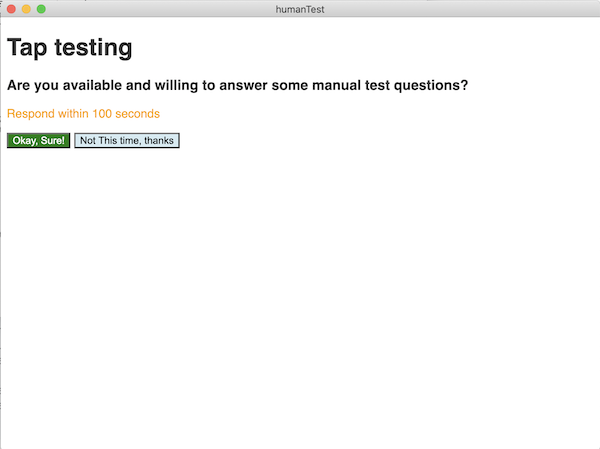 |
||
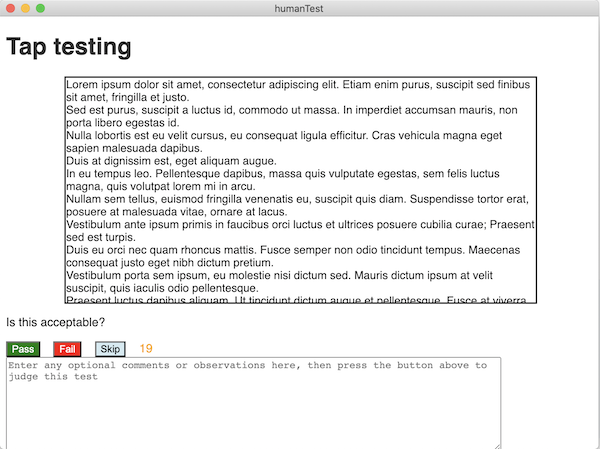 |
||
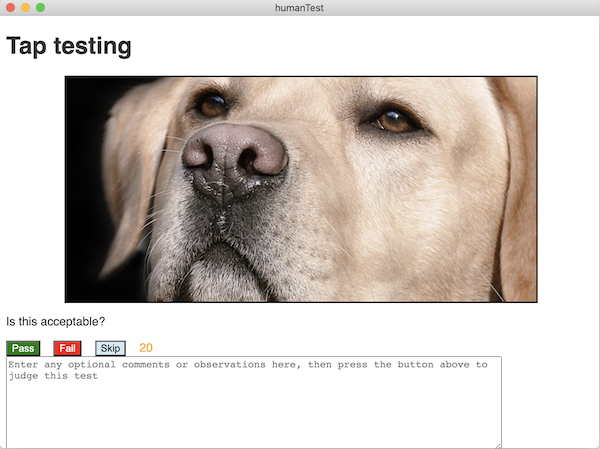 |
||
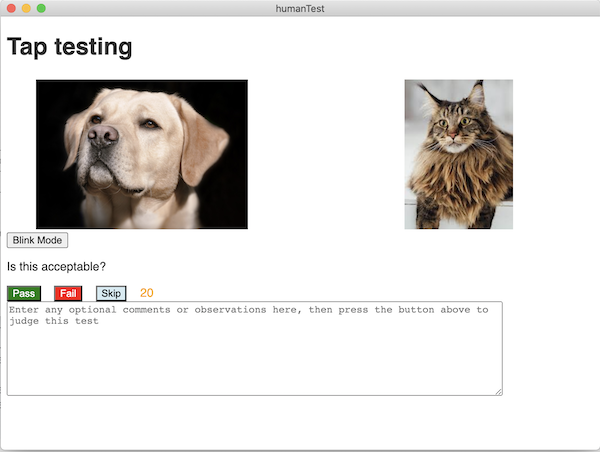 |
||
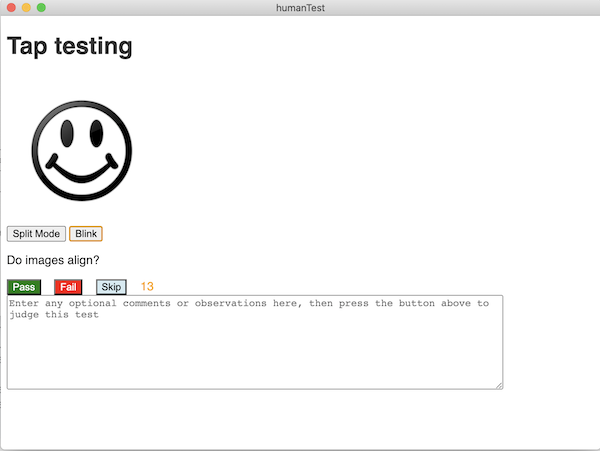 |
Installation
npm install --save-dev human-test
Usage
Use within the module of your test code.
var humanTest = require('human-test')
humanTest.startManualTests('Title to Display')
humanTest.verifyHumanAvailable().then(result => {
// process the result if desired
})
humanTest.viewFile('path/to/file.txt').then(result => {
// process the result for passed / skipped, etc.
})
alternately:
var {
startManualTest,
endManualTest,
viewFile,
showText,
diff,
viewImage,
compareImages
} = require('humanTest')
async function testStuff() {
startManualTests('Title to Display')
await verifyHumanAvailable().then(result => {
// process the result if desired
})
await viewFile('path/to/file.txt').then(result => {
// process the result for passed / skipped, etc.
})
// ... other commands as desired
endManualTest()
How you actually use the API in your test framework depends upon the test framework you prefer and what the syntax of that framework allows.
Using with Tap
TapJS is the preferred testing framework of this author, but
if you don't agree, that's okay.
TapJS has good support for asynchronous testing, and allows for tests to be marked as skipped after they have been started, and unless otherwise directed, will execute the test operations in the order written, and these characteristics are all a plus in this context, at least. TapJS has many other advantages over many of the other popular and historically common Javascript test frameworks available. If you are not already familiar with it, check it out.
Here is an example test script designed for Tap:
process.env.TAP_TIMEOUT = 0 // Required so tap doesn't timeout (or run tap with --no-timeout)
// import the modules we need
const humanTest = require('human-test')
const tap = require('tap')
const fs = require('fs')
const path = require('path')
// define the constants we'll use in testing
const exampleRoot = path.join(__dirname, 'example')
const fileToView = path.join(exampleRoot, 'textFile.txt')
const fileToDiff = path.join(exampleRoot, 'diffFile.txt')
const picToView = path.join(exampleRoot, 'dog.jpg')
const picToDiff = path.join(exampleRoot, 'cat.jpg')
const smiley = path.join(exampleRoot, 'smiley.png')
const noSmiley = path.join(exampleRoot, 'no-smiley.png')
const stringToView = 'The time is now for all good foxes to jump over the lazy dog\'s back'
// conduct the test
tap.ok(humanTest, 'module loaded')
tap.ok(humanTest.startManualTest, 'function should be exported')
tap.ok(humanTest.endManualTest, 'function should be exported')
tap.ok(humanTest.viewFile, 'function should be exported')
tap.ok(fs.existsSync(exampleRoot), 'Expect example directory to exist')
// Do the human parts of testing:
humanTest.startManualTest('Tap testing')
// verifyHuman has a default timeout of 120 seconds, so we need to wait at least that long
tap.test('Verify Human', t => {
humanTest.verifyHumanAvailable().then(result => {
// t.ok(result.passed)
t.end()
})
})
// other tests have a timeout of 30 seconds, which matches Tap's default timeout, so no real need to set it for these.
tap.test('viewFile Test', t => {
humanTest.viewFile(fileToView).then(result => {
if (result.skipped) tap.skip(result.comment)
else t.ok(result.passed, result.comment)
t.end()
})
})
tap.test('showText Test', t => {
humanTest.showText(stringToView).then(result => {
if (result.skipped) t.skip(result.comment)
else t.ok(result.passed, result.comment)
t.end()
})
})
tap.test('viewImage Test', t => {
humanTest.viewImage(picToView).then(result => {
if (result.skipped) t.skip(result.comment)
else t.ok(result.passed, result.comment)
t.end()
})
})
tap.test('diff Test', t=> {
humanTest.diff(fileToView, fileToDiff).then(result => {
if (result.skipped) t.skip(result.comment)
else t.ok(result.passed, result.comment)
t.end()
})
})
tap.test('compareImages Test', t => {
humanTest.compareImages(picToView, picToDiff).then(result => {
if (result.skipped) t.skip(result.comment)
else t.ok(result.passed, result.comment)
t.end()
})
})
tap.test('blink images Test', t=> {
humanTest.compareImages(noSmiley, smiley, {
specialNotice: "Use the 'blink' feature to verify smile goes on face properly",
prompt: "Do images align?"
}).then(result => {
if (result.skipped) t.skip(result.comment)
else t.ok(result.passed, result.comment)
humanTest.endManualTest()
t.end()
})
})
Using with Jasmine
Jasmine is a very popular test framework, although it is getting a little long in the tooth these days. Jasmine is also representative in basic approach and syntax to a number of related or dependent frameworks, such as mocha, jest, and many others
Jasmine tests have the following disadvantages over Tap, in the context of using humanTest:
- Tests will execute in a random order
- If a
HumanTesttest results in a 'skipped' test, there is no way for Jasmine to mark the test it is currently running as skipped. Using some other reporting mechanism is recommended.
Here is an example test script designed for Jasmine:
// import required modules
const humanTest = require('human-test')
const fs = require('fs')
const path = require('path')
// define the constants we'll use in testing
const exampleRoot = path.join(__dirname, '..', 'example') // jasmine starts life in the spec directory
const fileToView = path.join(exampleRoot, 'textFile.txt')
const fileToDiff = path.join(exampleRoot, 'diffFile.txt')
const picToView = path.join(exampleRoot, 'dog.jpg')
const picToDiff = path.join(exampleRoot, 'cat.jpg')
const smiley = path.join(exampleRoot, 'smiley.png')
const noSmiley = path.join(exampleRoot, 'no-smiley.png')
const stringToView = 'The time is now for all good foxes to jump over the lazy dog\'s back'
// Tests for non-manual aspects of the system under test are conducted as always
describe("Jasmine HumanTest suite", function() {
it("HumanTest module was loaded", function () {
expect(humanTest).toBeDefined()
});
it("HumanTest module exports expected functions", function () {
expect(humanTest.startManualTest).toBeDefined()
expect(humanTest.endManualTest).toBeDefined()
expect(humanTest.viewFile).toBeDefined()
});
it('Expect example directory to exist', function () {
expect(fs.existsSync(exampleRoot)).toBe(true)
})
})
// Manual (human) testing is bracketed by the startManualTesting and endManualTesting API calls.
// which we'll put in our `beforeAll` and `afterAll` handlers.
describe('Begin Manual Testing', function() {
// We must set the jasmine timeout to be greater than the timeout for verifyHumanAvailable
// or beforeAll will exit early and the tests will run prematurely and fail
// Note that we could set this to 30 seconds after verifyHuman to match the default for each test from then on, but there's no need.
var defTimeout = jasmine.DEFAULT_TIMEOUT_INTERVAL;
jasmine.DEFAULT_TIMEOUT_INTERVAL = 120000; // neutralize jasmine async timeout
beforeAll(function() {
humanTest.startManualTest('Jasmine Tests')
return humanTest.verifyHumanAvailable()
})
afterAll(function(done) {
jasmine.DEFAULT_TIMEOUT_INTERVAL = defTimeout
humanTest.endManualTest()
done()
})
it('View File', async function() {
const result = await humanTest.viewFile(fileToView)
// Jasmine has no provision for marking a test skipped once it has started executing.
// Other frameworks might.
// Alternately, you may choose to mark a skipped test as 'failed' but with a specific label so it is
// recognized as a skipped test in the test report.
expect(result.skipped).not.toBe(true)
expect(result.error).not.toBeDefined()
expect(result.passed).toBe(true)
// Handle comments in any way that makes sense to your test reporting system.
if(result.comment) console.log('ViewFile comment ' + result.comment)
})
it('Show Text', async function() {
const result = await humanTest.showText(stringToView)
expect(result.passed).toBe(true)
})
it('View Image (and use options)', async function() {
const result = await humanTest.viewImage(picToView, {
prompt: "Is this a dog?", // give our own prompt text
specialNotice: 'Study the picture carefully and answer truthfully', // This is a special notice that will pop up over test display.
timeout: 45, // give a slightly longer timeout (default is 30 seconds)
width: 500, // viewImage also accepts width and height options
height: 500
})
expect(result.passed).toBe(true)
})
it('diffText', async function() {
const result = await humanTest.diff(fileToView, fileToDiff)
expect(result.passed).toBe(true)
})
it('compareImages', async function() {
const result = await humanTest.compareImages(picToView, picToDiff)
expect(result.passed).toBe(true)
})
it('blink compare test', async function() {
const result = await humanTest.compareImages(noSmiley, smiley, {
specialNotice: "Use the 'blink' feature to verify smile goes on face properly",
prompt: "Do images align?"
})
expect(result.passed).toBe(true)
})
});
Handling comments, or unhandled skips
Built-in as of v0.3.0
The below discussion outlines how one might construct one's own test report handling.
As of v0.3.0, however, this functionality is built-in.
Simply use prepareReport(options) and/or consoleReport() (see API docs for details).
The previously published information on how to do this yourself is still valid, and follows:
Creating your own test handling
When a TestResponse object is returned from a HumanTest test command,
any comments the user entered in the GUI app's test area is relayed in the
comment property. What can practically be done with this information
is up to you (and possibly your choice of test framework).
You may choose to simply output it to the console, but this ephermeral sort of
handling is rarely sufficient to capture meaningful data.
Consider recording the results of tests yourself, in a Map object (which could be just a plain object) that records each test result by test name. Then output your own reporting of this manual test feedback to use as an appendix to the test report generated by your test framework.
For frameworks where a test marking itself as skipped is not an option, this may also be an appropriate mechanism for reporting this level of feedback as well.
Perhaps the following psuedo-code outlining this idea will be inspirational to your own implementation:
const htResultsMap = {}
// hopefully you'd make a prettier output than this, but
// even an object dump is informative for this purpose
function reportHumanTestResults() {
Object.getOwnPropertyNames(htResultsMap).forEach(name => {
const results = htResultsMap[name]
console.log(name, results)
})
}
// conduct the tests
/*do the test called testname */ => result => {
htResultsMap[testname] = result;
})
...
// when all done
reportHumanTestResults()
Using with other test frameworks
There should be no reason that any test framework can't be made
to work with HumanTest.
If you have examples of using other test frameworks, please share them. Use the contact information in this readme and/or post as an issue or pull request to the GitHub repository.
Some things to know:
-
The
HumanTestDisplay app is an Electron-based app process that reads and writes via stdin/stdout to communicate with the test harness. -
The
HumanTestDisplay app is designed to run on Mac, Windows, and Linux platforms, but has not been extensively tested on all system variants. If you experience problems with this in any way on your platform, please contact us. -
If the remote GUI app fails to run after
startManualTestis called (for example, when running on a headless CI ), all the subsequent tests will return 'skipped' (similar to the timeout case ofverifyHumanAvailable, but without the 2-minute wait) -
HumanTestautomatically gates access to each test, so if a test is in progress, a call to run the next test will wait until the prior one finishes.
Test timeouts
Make sure you have either disabled or suspended the default timeout for asynchronous operations for whatever test framework you are using, since the human-enacted tests can easily exceed these limits.
API
Table of Contents
- ReportFormat
- ReportOptions
- startManualTest
- endManualTest
- verifyHumanAvailable
- viewFile
- showText
- diff
- viewImage
- compareImages
- produceReport
- consoleReport
- TestResponse
- TestOptions
ReportFormat
Types of report formats that may be used
ReportOptions
Options for report output
| property | type | default | purpose | |
|---|---|---|---|---|
format |
string | 'text' | Chooses the format of the report output. Must be one of the ReportFormat types |
|
headingSize |
string | number | 0 | Integer between 0 (largest) to 3 (smallest) determines size of headings used (html and markdown) . |
file |
string | undefined | If defined, specifies the base name of a file the report will be output to. The extension is provided by the code according to prefix ('.txt', '.html', or '.md') |
startManualTest
Starts manual testing, providing a title.
This launches the remote GUI app and supplies the title that will be displayed on the GUI app page. The remote app is then ready to receive commands from the harness.
This must be called before any tests are conducted.
When done with all tests, call endManualTest()
Parameters
titlestring? If not given, a default title will be displayed
Examples
Returns any Promise Return can be ignored; resolves to 0 if remote app launched successfully.If the remote app does not run, subsequent tests are skipped.
endManualTest
Stops manual testing and closes the remote app. This should be called after the last test command is handled.
Examples
verifyHumanAvailable
Verifies that a human is available to conduct the tests. Timeout default for this command is 60 seconds. If no response is received in that time, this test response will be with 'skipped = true' and 'error = timeout'. Also in that case, all subsequent tests are automatically skipped, with the comment 'unattended'
Parameters
optionsTestOptions The 'timeout' option property is honored here (default = 120)
Examples
viewFile
Displays the contents of a text file and prompts the user for pass/fail/skip or comments
Parameters
filenamestring File with text to be displayedoptionsTestOptions options for this command (e.g. prompt, timeout)
Examples
showText
Displays the given text and prompts the user for pass/fail/skip or comments
Parameters
textstring Text to be displayedoptionsTestOptions options for this command (e.g. prompt, timeout)
Examples
diff
Displays the contents of a two sets of text or two text files as a side-by-side diff and prompts the user for pass/fail/skip or comments
arg is treated as a filename if file exists at the path, otherwise as text.
Parameters
arg1string Filename or text (left side)arg2string Filename or text (right side)optionsTestOptions options for this command (e.g. prompt, timeout)
Examples
viewImage
Displays the image file and prompts the user for pass/fail/skip or comments
Parameters
filenamestring Image file to be displayedoptionsTestOptions options for this command (e.g. prompt, timeout, width, height)
Examples
The `width` and `height` options are recognized by this command:compareImages
Displays two images in a manner that they may be compared and prompts the user for pass/fail/skip or comments
Parameters
file1string First Imagefile2string Second ImageoptionsTestOptions options for this command (e.g. prompt, timeout)
Examples
`compareImages('image1.png', 'image2.jpg').then(result => { if(result.passed) console.log('looks okay!') else if(result.skipped) console.log('test was skipped') else console.error('test failed!')})` For any command the `specialNotice` property can be used to give the user more information on how to conductthe test That is useful for `compareImages` since it provides two view modes the user can employ for analysis`compareImages('image1.png', 'image2.jpg', {specialNotice:'use the blink compare tool!'}).then(result => { ...})`produceReport
Outputs a report to a file
Note the reportOptions.file property must have a path to a file base name (no extension).
The reportOptions.format should also be set, although it will default to 'text'.
Parameters
reportOptionsReportOptions -- The options for report output
Examples
Returns any Promise resolves when file has been written (may generally be ignored)
Meta
- since: v0.3.0
consoleReport
Retrieves a text format report suitable for output to the console
Parameters
inColorboolean if true, the report text will contain ANSII color escape codes.
Examples
Returns any Promise resolves with the text of the report when ready.
Meta
- since: v0.3.0
TestResponse
Object structure returned by a test. Tests return a Promise that resolves with an object with the following properties:
| Property | Type | Purpose |
|---|---|---|
| passed | boolean | True if the test has passed, false if not; will be undefined for skip or error |
| skipped | boolean | True if test was skipped, undefined otherwise |
| comment | string | If defined, will contain any comment entered by the human tester for this test |
| error | string | If defined, will signify an error has occurred, and will hold the error message |
TestOptions
Options that may be passed to each command. If not given, defaults for each value are used.
Note: in v0.3.0 the default test timeout was changed from 30 to 60
| Property | Type | Default | Purpose |
|---|---|---|---|
| prompt | string | "Is this acceptable?" | The prompt to display to the user |
| specialNotice | string | A message displayed in a modal alert dialog to gove the user special instruction | |
| title | string | previous | (since v0.3.0) Changes the main title. The title is initially set with startManualTest, and can be changed with any command. The title will persist beyond the life of the command, until changed again. |
| name | string | derived from command | (since v0.3.0) assigns the test naem that the results appear under in the HumanTest Report output |
| timeout | number | 60 (120 for verifyHuman) | The number of seconds before a timeout occurs, and test skipped |
| width | number | (imageView Only) Defines the width used for the image display, in pixels. If not provided, the full image width is displayed. |
|
| height | number | (imageView Only) Defines the height used for the image display, in pixels. If not provided, the full image height is displayed. |
Known issues
There are currently no known issues. See also the Github repository issues page
Contributing
If you have ideas for making HumanTest better, please visit
the Github repository issues page
page and record your suggestions there.
If you would like to commit code that addresses an outstanding issue, please fork the repository and post a pull request with your changes.
If you simply want to comment or if you have other reason to contact me, feel free to send me email at mailto:steve@ohmert.com



